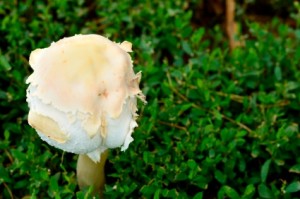 You might have trouble remembering critical differences between plants and fungi unless you’re a botanist. Don’t let this get you down. While their cell structures and metabolic processes are very different, many types of plants and fungi appear to grow and reproduce in similar ways. Consult this handy guide if you see a strange organism popping up through your lawn’s grass.
You might have trouble remembering critical differences between plants and fungi unless you’re a botanist. Don’t let this get you down. While their cell structures and metabolic processes are very different, many types of plants and fungi appear to grow and reproduce in similar ways. Consult this handy guide if you see a strange organism popping up through your lawn’s grass.
Are All Fungi Bad?
First, it’s important to note that not all fungi harm your lawn. Many species break down organic matter that can harbor grass-eating pests or give rise to weeds that choke the life out of your lawn. Indeed, many homeowners use fungi in walled-off areas to break down organic waste like sawdust, wood chips, mulch, tree droppings, and food byproducts.
Critical Types of Flower-Mimicking Fungi
Here’s some helpful science: Mushrooms are the “fruiting bodies” of the underground fungal structure known as mycelium. In other words, they’re the “flowers” of the fungal kingdom. Whether they look like beautiful flowers or shapeless, ugly blobs, mushrooms exist to spread single-celled spores that can develop into new fungal colonies under the proper conditions.
Mushrooms that can easily be confused with flowers include:
• Leucocoprinus birnbaumii: small, yellowish, cylindrical bodies that often appear in clusters
• Conocybe tenera/brown cone head: brown bodies with slender heads and thin caps that are often shorter than surrounding grasses
• Lysurus borealis/lizard’s claw: white and brown bodies with thick stems and distinctive caps that resemble flower petals
All of these species (and many others) have the potential to out-compete lawn grasses under the right conditions.
Why Do They Like Your Lawn So Much?
Fungi prefer moist, shaded environments with ample decaying organic matter. You’ll notice that many crops up in the shadow of older trees or areas where trees and shrubs used to stand. The reason for this is simple: Old, decaying tree roots provide a treasure trove of nutrients for fungal structures to grow. Once a spore touches down in a favorable environment, it quickly begins to multiply. If conditions stay ripe for a sufficient time, you’ll start seeing mushrooms.
What You Can Do About It
You can fight harmful mushrooms in several ways. First, remove any caps or structures that you see. While this won’t prevent spores from arriving on your lawn on a stiff breeze, it will avoid localized spreading. Additionally, limit your watering activities. Mushrooms prosper in wet environments, and it’s possible to restrict the growth of many species without starving your grass. Don’t forget to remove clumps or piles of organic material, including leaf litter. Finally, properly aerating and fertilizing your lawn can tip the balance in favor of your grass.
Fighting invasive weeds and fungi can seem like a never-ending battle, but you don’t have to defend your lawn alone. At ABC Home & Commercial Services in Houston, our seasoned lawn care professionals can quickly identify unwanted intruders and take steps to prevent their return. To learn more about how to keep your lawn free of fungi and turn your plot into the envy of the neighborhood, call us at 281-730-9500 or visit us online.